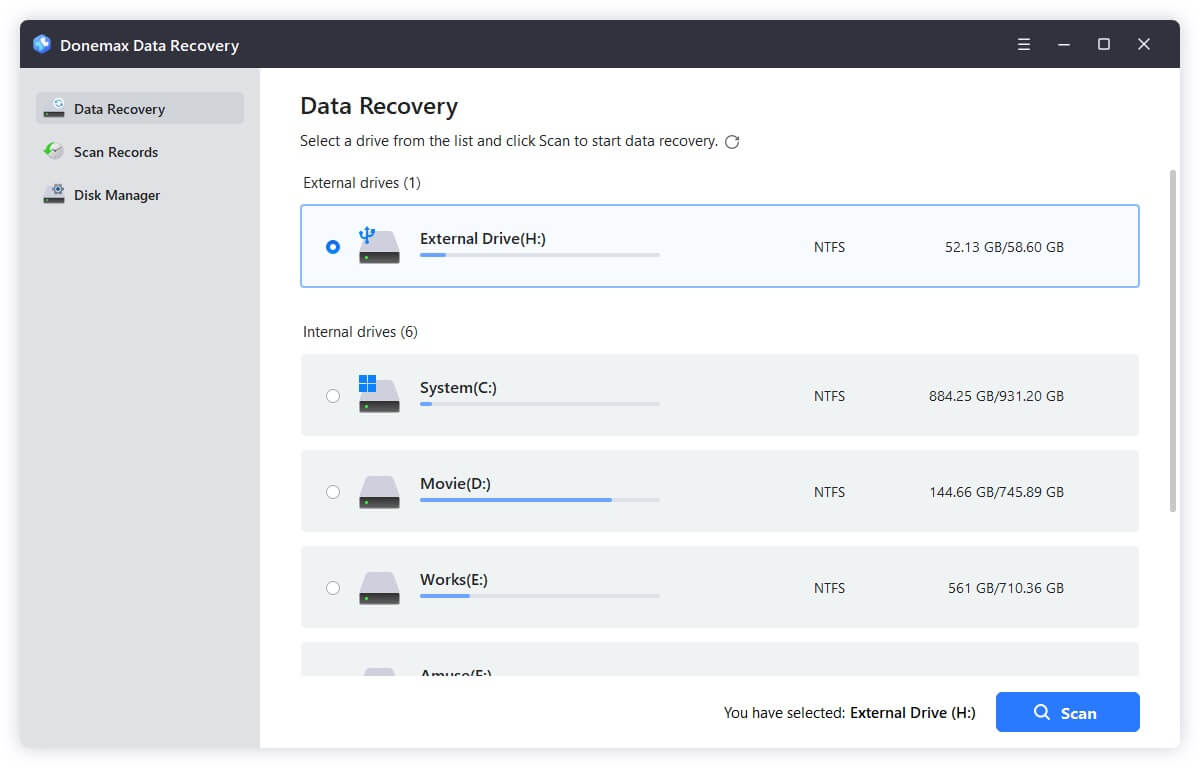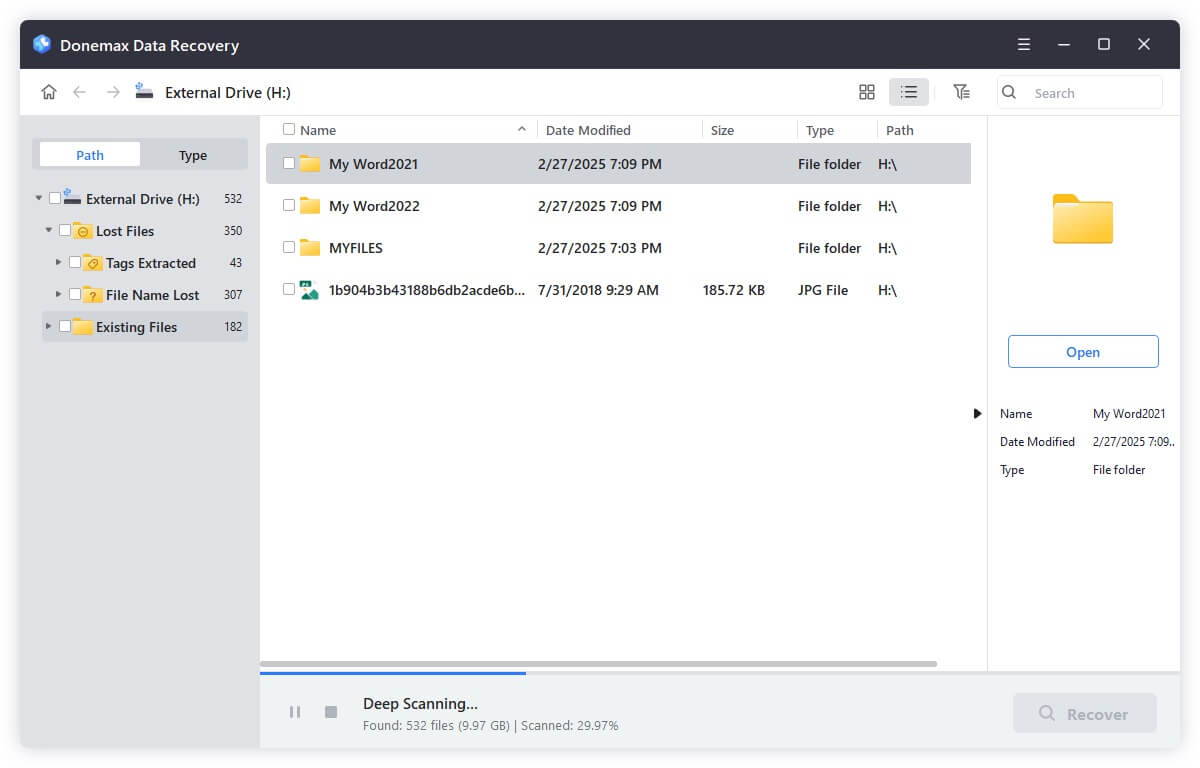Before we start: To recover deleted, formatted, or other lost data from ADAT SSD, using the most effective tool Donemax Data Recovery. It can deeply scan the drive to search for any possible recoverable files and easily recover the files.
PAGE CONTENT:
ADATA SSDs are widely used for their speed, reliability, and affordability. However, like all storage devices, ADATA SSDs are vulnerable to data loss, system errors, and physical failures. Whether due to accidental deletion, formatting, or hardware malfunction, losing critical data from your SSD can be frustrating and stressful.

This detailed guide will walk you through common causes of data loss, practical methods for ADATA SSD data recovery, repair solutions, and tips to prevent future incidents. Whether you're using an ADATA SATA SSD, external SSD, or NVMe SSD, you'll find solutions tailored to your device.
Common Causes of Data Loss on ADATA SSDs
Understanding what causes data loss is essential for choosing the right recovery and repair approach. The most frequent causes include:
- Accidental Deletion: Files mistakenly deleted from the SSD can often be recovered unless they are overwritten by new data.
- File System Corruption: Improper shutdowns, power failures, or virus attacks can corrupt the file system, making data inaccessible.
- Unrecognized SSD: An SSD may not appear in Windows Explorer, Disk Management, or BIOS due to connection issues or drive corruption.
- Partition Loss or Formatting Errors: Accidental formatting or partition deletion can lead to the loss of entire data sets.
- Firmware Malfunctions: Outdated or corrupted firmware may cause the SSD to misbehave or become undetectable.
- Wear-Leveling and Lifespan: All SSDs, including ADATA models, have a limited number of write cycles. When these are exhausted, the drive may fail.
- Malware Attacks: Viruses and ransomware can corrupt or encrypt files, making them inaccessible.
Signs of a Failing or Corrupted ADATA SSD
If your SSD shows any of these warning signs, immediate action is recommended:
- SSD not recognized in BIOS or Disk Management
- Operating system freezes or crashes frequently
- Unusual slowdown in file transfer speeds
- Files or folders disappearing suddenly
- SSD showing as RAW or unallocated space
- Detection errors on multiple systems
Preparing for Data Recovery
Before beginning any recovery steps:
- Stop Using the SSD: Continued use can overwrite lost files, reducing recovery chances.
- Check Warranty Status: If under warranty, avoid physical tampering.
- Have the Right Tools Ready: You may need data recovery software, SATA-to-USB adapters, or another working computer.
Methods to Recover Data from ADATA SSD
Losing data from your ADATA SSD can happen suddenly—whether it's due to accidental deletion, corruption, or hardware glitches. Fortunately, with the right tools and techniques, recovery is often possible, especially if you act quickly. Below is a detailed, step-by-step approach to recovering data from different ADATA SSD models, including SATA, external, and NVMe drives.
Check Physical Connections
Before assuming the worst, confirm that your SSD is properly connected:
For Internal ADATA SSDs (SATA/NVMe):
- Open your PC case and check SATA cables and power connections.
- For NVMe SSDs, ensure the drive is seated firmly in the M.2 slot.
- Try swapping cables or using a different M.2 slot if available.
For External ADATA SSDs:
- Test the SSD on another computer to rule out system-specific issues.
- Use a different USB port, preferably a USB 3.0 port for better performance.
- If available, try a different USB cable or adapter.
💡 Note: If the SSD heats up abnormally or remains undetected after basic checks, skip to professional recovery options to avoid further damage.
Verify Detection Using Disk Management or Disk Utility
If your SSD is connected but not visible in File Explorer (Windows) or Finder (Mac), it may still be detectable at a system level:
Windows (Disk Management):
- Right-click the Start menu and select Disk Management.
- Look for the ADATA SSD in the drive list.
- If detected but no drive letter is assigned:
- Right-click the partition and select Change Drive Letter and Paths.
- Assign a new drive letter.
- If shown as RAW or Unallocated, data recovery is still possible—avoid formatting at this stage.
macOS (Disk Utility):
- Go to Applications > Utilities > Disk Utility.
- Check if the SSD is listed on the left sidebar.
- Try to mount the drive if it appears grayed out.
- If First Aid repair option is available, run it, but do not erase the disk before recovery.
Use Reliable Data Recovery Software
When system tools fail to access files, dedicated recovery software can scan the SSD's memory for lost data.
Recommended Data Recovery Tools:
- Donemax Data Recovery: Beginner-friendly with deep scan features.
- Stellar Data Recovery: Excellent for RAW drives or formatted SSDs.
- Disk Drill: Known for its high success rate with SSDs and external drives.
- R-Studio: Ideal for technical users needing in-depth recovery control.
Step-by-Step Recovery Process (Using Donemax Data Recovery):
Step 1. Install the data recovery program on a different drive, not the affected ADATA SSD, to avoid overwriting lost data.
Donemax Data Recovery
- Top 1 and most trusted data recovery software.
- Compatible with both latest Windows and macOS systems.
- Data recovery for deleted, formatted, or other lost data.
Step 2. Connect the ADATA SSD to the computer and ensure the SSD is properly detected by the system or through the recovery tool interface. Choose the ADATA SSD from the list of available drives.

Step 3. Click the Scan button and the software will start to search for missing files from the selected drive. For formatted or RAW SSDs, the software will automatically start a deep scan.

Step 4. After scanning, preview recoverable files such as documents, images, videos, and archives. Select the files to restore and save them to a secure, separate location (never on the affected SSD).

Special Considerations:
- If scanning takes unusually long or the SSD disconnects, overheating may be an issue; allow the drive to cool before retrying.
- Large-capacity SSDs may require several hours for deep scans—be patient.
Recover Data from a Formatted ADATA SSD
Accidental formatting is common, but recovery is feasible:
- Quick Format vs. Full Format:
- Quick formats remove the file system index but leave data physically intact.
- Full formats overwrite data, making recovery difficult or impossible.
💡 Recovery Tip: Use tools like Donemax Data Recovery an Do Your Data Recovery with deep scan capabilities to locate files from formatted ADATA SSDs. The sooner you attempt recovery after formatting, the better your chances of success.
Data Recovery Tips for ADATA NVMe SSD
ADATA NVMe SSDs (like the ADATA XPG series) use ultra-fast PCIe lanes, presenting unique recovery challenges:
- Ensure your system BIOS and OS support NVMe drives.
- Some recovery software may require additional drivers for NVMe detection.
- Recovery steps are similar to SATA SSDs, but always:
- Use updated recovery tools with NVMe support (e.g., Donemax).
- Verify drive health via ADATA SSD ToolBox before recovery attempts.
If your NVMe SSD isn't recognized even after troubleshooting, professional recovery may be required as NVMe controller failures are complex.
Handling an Undetectable ADATA SSD
In severe cases where your SSD is:
- Not visible in BIOS
- Unrecognized by any recovery tool
- Shows no signs of power or activity
Possible Causes:
- Firmware corruption
- Physical controller damage
- Electronic board failure
Solutions:
- Consult ADATA support for firmware recovery tools (if applicable).
- Contact a professional data recovery lab with chip-level extraction capabilities.
- Do not open the SSD casing yourself, as this voids warranties and risks further damage.
By following these expanded steps, users can systematically approach data recovery for ADATA SSDs, increasing the likelihood of successful restoration.
When to Seek Professional Data Recovery Services
Some issues are beyond home recovery methods. You should consult professional services if:
- The SSD is not detected by any computer or recovery software.
- There's severe physical damage (water, fire, or shock).
- Firmware is corrupted, making the drive inaccessible.
- The SSD's controller has failed.
Trusted Data Recovery Providers:
- DriveSavers
- Ontrack
- Gillware
Professional labs can handle NAND chip-level recovery, which is impossible with consumer tools.
Preventing Future Data Loss
1. Implement Regular Backups
- Use the 3-2-1 Backup Strategy: three copies of data, on two different storage mediums, with one off-site (like cloud storage).
2. Monitor SSD Health
- Check SSD health regularly using ADATA SSD ToolBox.
- Watch for high bad block counts or declining SMART indicators.
3. Update Firmware
- Firmware updates fix bugs and prevent certain types of corruption.
4. Avoid Power Surges
- Use a UPS for desktop systems to avoid sudden shutdowns that can damage SSDs.
5. Handle with Care
- External SSDs are portable but still vulnerable to physical damage.
6. Replace Aging SSDs
- If your SSD is nearing its expected lifespan (often rated in TBW—Terabytes Written), plan for a replacement before failure occurs.
Conclusion
ADATA SSDs offer fast, reliable storage, but they're not immune to failure. Whether you've accidentally deleted files, experienced system crashes, or are facing a non-responsive SSD, timely and informed action can greatly improve your chances of recovery.
Start by assessing the issue, use the right data recovery software, and explore repair utilities like the ADATA SSD ToolBox. For severe cases, don't hesitate to consult professional data recovery services. Most importantly, prioritize preventative measures like regular backups, SSD monitoring, and firmware updates to safeguard your valuable data.
With this step-by-step guide, you're now equipped to recover and repair your ADATA SSD efficiently and minimize the risk of future data loss.


Donemax Data Recovery
Powerful, safe & easy-to-use data recovery software. Easily and completely recover deleted, formatted, or other lost data. The tool supports PC, Mac, HDD, SSD, USB drive, camera, SD card, RAID and other storage devices.
Related Articles
- May 16, 2025Recover Files Which Are Disappeared from an External Hard Drive
- Jul 04, 2024Best 4 Samsung Data Recovery Software
- May 10, 2024How to Recover Lost Data from GoPro HERO12 Black?
- Oct 31, 2023How to Recover Deleted WPS Office Documents?
- Nov 27, 2024Unformat a RAW Drive or Corrupted Drive: A Comprehensive Guide
- Oct 28, 2024How to Recover Lost MKV Videos – A Comprehensive Guide

Steven
Steven has been a senior writer & editor of Donemax software since 2020. He's a super nerd and can't imagine the life without a computer. Over 6 years of experience of writing technical solutions and software tesing, he is passionate about providing solutions and tips for Windows and Mac users.

Gerhard Chou
In order to effectively solve the problems for our customers, every article and troubleshooting solution published on our website has been strictly tested and practiced. Our editors love researching and using computers and testing software, and are willing to help computer users with their problems
